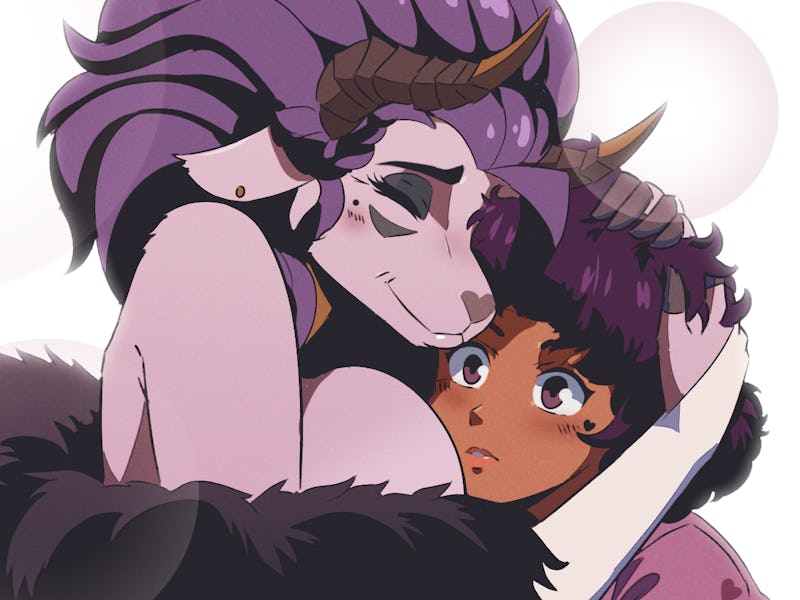Horror and Romance Make Surprisingly Good Partners In Sucker for Love: Date to Die For
Love is scary.

Love can make people do foolish things, like move in with someone you just met, pretend you’re really into hiking, or engage in ritual blood sacrifice to appease an elder god. We’ve all been there. So seeing that oh-so-common experience dramatized in Sucker for Love: Date to Die for, the latest visual novel from developer Akabaka, feels like a breath of fresh air.
Date to Die for is a sequel to 2020’s Sucker for Love: First Date, a visual novel about summoning unfathomable beings from beyond reality in order to smooch them. Date to Die for maintains the original’s unlikely but potent mix of cosmic horror, comedy, and romance, but with improved gameplay, a scarier atmosphere, and a vastly more interesting story.
Date to Die for starts as a young woman (who’s only referred to by the nickname Stardust) arrives in her hometown of Sacramen-Cho. She’s on the hunt for her parents, who are among dozens of people to go missing recently. Upon arriving, she meets a bloodthirsty doomsday cult that’s sacrificing or converting the town’s inhabitants, and takes shelter in her grandma’s house. Using a mysterious book of rituals, Stardust summons the cult’s twisted deity to free her home from their grasp.
Enter Rhok’zan. The busty, beautiful fertility goddess with the head of a goat appears to Stardust and reveals that she, too, has been trapped here. Using her power to amplify people’s desires, the cult is turning its victims into mindless slaves. The only thing keeping Stardust from falling under Rhok’zan’s power (which she explains magnifies desire a thousandfold) is the fact that she’s asexual and has no sex drive for the goddess to increase. “A thousand times zero is zero,” Stardust says.
So the unlikely duo embark on a quest to undo the cult’s hold on Sacramen-Cho by completing all the rituals in Stardust’s book and banishing Rhok’zan from Earth. For the player, that means following a set of precise instructions to cast all the necessary spells. Each one typically requires prowling through the house for ingredients ranging from raw flesh to strawberry milk, manipulating candles and other material at Rhok’zan’s altar, and physically dragging your mouse across the words on the page slowly to recite an incantation.
With only about a dozen rooms to explore and a repeating scavenger hunt structure, it may seem like Date to Die for could get old fast, despite Rhok’zan’s charms. But Stardust’s family home has been turned into a house of horrors by the cult, and just the act of moving from room to room is a harrowing experience. The door to each room has to be opened manually, by sliding your mouse to open it, and with the potential of a knife-wielding cultist around every corner, this mundane gesture becomes terrifying. Each of the game’s four chapters offers a different twist on the horrors stalking Stardust, which changes the way you need to move through the house throughout its roughly five-hour runtime.
Players explore the house from a first-person perspective, hunting for ritual items in rooms filled with occult symbols and decay. As frightening as its visuals are, sound contributes even more to the oppressive dread of the game’s atmosphere, as Stardust’s heart thumps in her ears and unexplained noises fill the house. I’d highly recommend wearing headphones to wring the most tension possible out of the experience. Date to Die for does sometimes rely on jump scares, but a helpful accessibility setting offers warnings before they pop up when it’s toggled on.
As much as Date to Die for is a horror game, it’s also a comedy. A particularly dark one, given all the ritual dismemberment, but a comedy nonetheless. Stardust’s interactions with Rhok’zan are as funny as her run-ins with the cultists are terrifying, and the game’s lighthearted tone comes across in other ways, too. The whole story is framed as a series of anime episodes, complete with “next time on” segments to end each chapter.
The game screen is also filtered to look like a somewhat grainy VHS tape, with a logo even burned into the top corner of the screen as if it were taped from a late-night anime broadcast on some obscure channel. It ends up fitting the game’s tone in more ways than one. While its parody anime aesthetics keep it lighthearted, the glitchy quality of the art filter causes distortions that flicker across the screen and disappear — a perfect match for the cosmic horror premise, where things beyond reality flit briefly into the corner of the eye and torment observers with their uncanniness.
I went into Date to Die for looking for cheap thrills. I liked the original Sucker for Love’s sense of humor, and a retread of that with the addition of demon goat mommy Rhok’zan as a central character just sounded like a good time. As a certified scaredy-cat, I can pretty much only stomach horror in visual novels, so getting to enjoy slasher movie vibes was a draw, too.
Date to Die for delivered everything I was hoping for, along with a surprisingly touching story of characters with complicated relationships to love and romance becoming unlikely allies in the worst possible circumstances. The thing I was least prepared for was how much it has in common with Slay the Princess, another visual novel that plays with the messy intersection of love and horror to fantastic results. Romance and world-ending cults may seem like poor bedfellows, but Date to Die for makes them perfect mates.